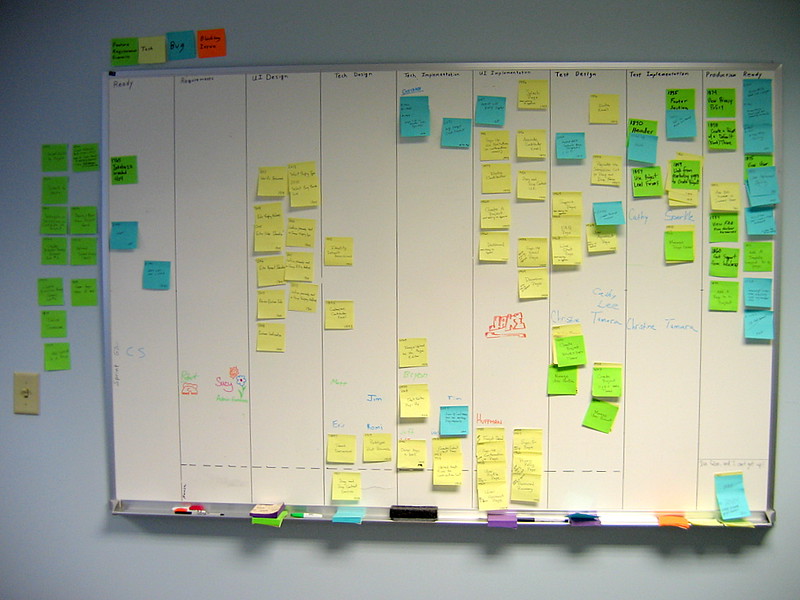In a constantly evolving digital landscape, Swiss and international companies are constantly seeking ways to improve their productivity, accelerate their delivery times, and remain competitive in the market, whether it’s for internal projects or those carried out for clients. This is where agile project management comes in, a dynamic approach that we at Edana consider crucial for the success of digital projects (such as software development, mobile application design, branding, digital transformation, or marketing).
In this article, we delve into the world of agile project management together, understanding what it is, how you can successfully get started, and why a hybrid approach can sometimes be the key.
Edana: strategic digital partner in Switzerland
We support companies and organizations in their digital transformation
What is Agile Project Management?
Agile project management is an iterative and collaborative approach that focuses on flexibility and responsiveness to change. Agility is often a catalyst for the success of projects in general (not just for IT and digital projects). This approach promotes continuous collaboration among team members, stakeholders, and the client, ensuring a better understanding of requirements and expectations.
Fundamental principles of agility
Client-team collaboration
Agility, by placing the client at the center of the development process, promotes continuous communication and close collaboration. This dynamic approach allows for constantly adjusting priorities based on the evolving needs of the client, ensuring quick and effective adaptation to changes throughout the development cycle.
Rapid iterations (sprints)
In agile methodologies, projects are subdivided into iterations called “sprints.” Each sprint, typically of short duration, focuses on delivering a specific functional deliverable. This iterative approach offers several advantages, including the ability for stakeholders to regularly assess progress. Indeed, at the end of each sprint, a partial or complete product is delivered, providing a concrete opportunity to gather immediate feedback from stakeholders. This rapid feedback fosters close collaboration between the development team and end-users, allowing for adjustments to features along the way and ensuring constant adaptation to the changing needs of the project.
Adaptability to changes
Unlike more rigid methodologies, agility takes a proactive approach to changes. It encourages teams to remain flexible and constantly adjust their plans based on the experience gained throughout the development process. This means that agile teams are not only open to adjustments but anticipate and actively integrate them into their way of working. By relying on stakeholder feedback and staying attentive to market developments, agile teams can make informed decisions to ensure that the final product optimally meets the client’s needs. This ability to embrace change as an opportunity rather than an obstacle strengthens the resilience of agile projects, making them better suited to the realities of an ever-changing environment.
A digital project? Let’s talk about it now.
Agile frameworks: A range of options for successful projects
Within the Agile universe, several frameworks offer specific structures and guidelines to guide project management. At Edana, we advocate diversity and are ready to guide you to the framework that best suits your objectives, whether it’s agile, non-agile, or a hybrid of agile and non-agile solutions (because the world is sometimes too complex to be confined to narrow boxes). Here are the main agile frameworks.
1. Scrum
Scrum represents an Agile project management framework that relies on time-boxed iterations, called sprints. Each sprint is structured by four distinct ceremonies.
The process begins with sprint planning, which provides an overview of the work to be done. In the Scrum universe, two types of backlogs are present: the product backlog (under the responsibility of the product owner), which constitutes a prioritized list of features, and the sprint backlog, fueled by addressing items from the product backlog until reaching the capacity of the next sprint. Scrum team members are assigned specific tasks corresponding to their role in the process. Typically, a cross-functional team includes a Scrum Master, or Scrum methodology champion, the product owner representing the voice of the product, as well as other members responsible for task execution.
The four Scrum ceremonies are as follows:
- Sprint planning: A team meeting to define the tasks to be accomplished during the next sprint.
- Sprint demo: A sharing session during which the team presents its achievements for the current sprint.
- Daily stand-up: Also called a stand-up, it’s a brief 15-minute meeting allowing the development team to coordinate their activities.
- Retrospective : An evaluation where the team reviews what worked or didn’t work to improve the flow of the next sprint.
The Scrum board

A Scrum board visualizes all the work for a given sprint. During the sprint planning meeting, the team moves items from the product backlog to the sprint backlog.
Scrum boards can include multiple visible workflow stages, such as To Do, In Progress, and Done. They are an essential element to increase transparency in Agile project management.
2. Kanban
Kanban represents an Agile project management framework focused on aligning work with team capacities, aiming to promote rapid progress and increased responsiveness to changes compared to the Scrum methodology.
Unlike Scrum, Kanban typically does not employ backlogs. Tasks are instead listed in the “To Do” column. Kanban teams thus focus on continuous deliveries, achievable at any time. All work is visible, clearly defined, and ready to be undertaken. When a task is completed, the team immediately moves on to the next one. Work volume is aligned with team capacity through work-in-progress (WIP) limits, a predefined threshold for tasks that can be in one column at a time (except for the “To Do” column). The Kanban framework includes four key components: the task list (or stories), columns or lanes, WIP limits, and continuous deliveries.
The task list, or stories, is detailed as tickets or tasks to be completed. Columns or lanes are used in a Kanban board to differentiate tasks according to different workflows, users, projects, etc. WIP limits are rules governing the volume of work based on team capacity. The team manages stories within WIP limits and can make deliveries at any time.
The Kanban board

A Kanban board visualizes all completed work. It also serves to plan resources, providing project managers with a view of the work and the ability to schedule accordingly.
The Kanban board is organized into columns and lanes, representing the passage of stories to completion. Stories start in the “To Do” column until the WIP limit allows for the next task. The work list must be subdivided into relatively small tickets and organized by priority.
3. Extreme Programming (XP)
Extreme Programming focuses on continuous improvement of the development process. It promotes practices such as test-driven development (TDD), pair programming, and frequent releases. XP aims to ensure optimal quality throughout the development process.
4. Lean Agile
Inspired by Lean principles, Lean Agile seeks to maximize value while minimizing waste. It emphasizes collaboration, transparency, and customer satisfaction. By eliminating non-essential processes, Lean Agile aims to create an efficient value chain.
5. Crystal
Crystal is a family of Agile methodologies, each tailored to specific contexts. The different Crystal methods share a philosophy focused on individuals, collaboration, and adaptability, while adjusting based on project size and complexity.
Balancing Agile and Waterfall: A hybrid approach
Although Agile and waterfall approaches have their distinct advantages, it is crucial to recognize that each project has its own unique requirements. A too rigid approach can sometimes be counterproductive. Too much agility can lead to constant instability. This is where the hybrid approach comes in, combining the best of both worlds.
The hybrid approach allows for a more structured initial planning while maintaining the flexibility needed to adapt to inevitable changes. Edana specializes in creating tailored approaches, skillfully combining elements of Agile and waterfall methodologies to meet the specific needs of each project.
Example of the Swiss HERMES method
The HERMES project management method, developed in Switzerland, is characterized by a structured and standardized approach. It divides the process into clear phases, emphasizing detailed documentation and rigorous governance. HERMES offers modular flexibility while maintaining a solid methodological foundation, allowing for adaptation to different projects. Unlike agility, which favors maximum flexibility, HERMES relies on planned processes but can also integrate agile elements based on the specific needs of the project and organizational preferences.
More information on the hybrid project management method HERMES on the admin.ch website.
Discuss your project with our software development, mobile, branding, and strategy experts
At Edana, we believe that success lies in flexibility and adaptability. Agile project management, enriched by the diversity of available frameworks, offers a flexible and adaptable approach. However, the hybrid approach can often be the key to getting the most out of each method, thus creating an optimal balance between initial structure and responsiveness to changes. With our experts by your side, explore the best solutions that apply to your project and make it a success.







 Views: 14016
Views: 14016